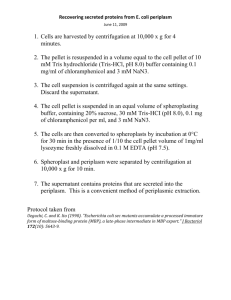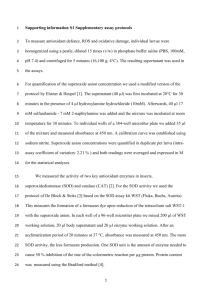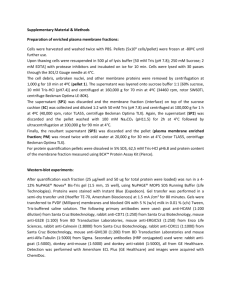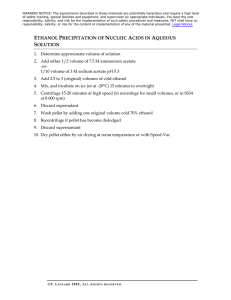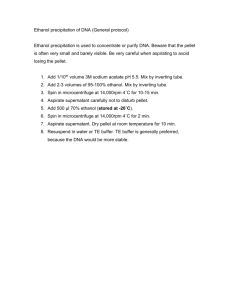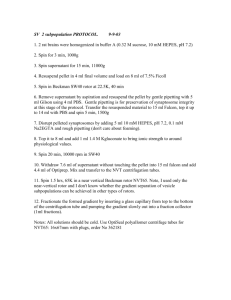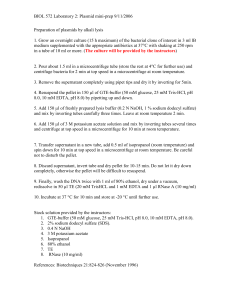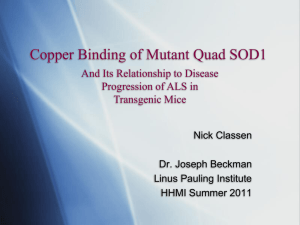Investigation of mutated Cu/Zn Superoxide Dismutase Sam Schuberg Beckman Laboratory
advertisement
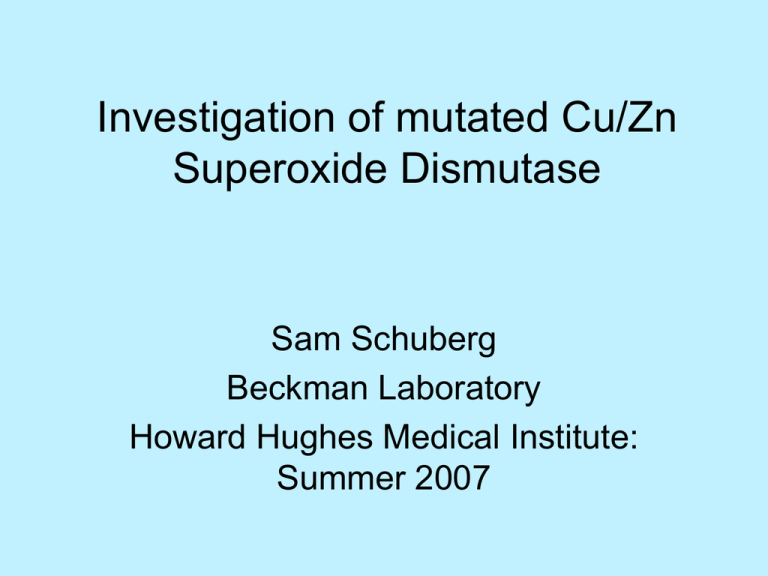
Investigation of mutated Cu/Zn Superoxide Dismutase Sam Schuberg Beckman Laboratory Howard Hughes Medical Institute: Summer 2007 Amyotrophic Lateral Sclerosis • Neurodegenerative disease caused by the destruction of the motor neurons along the spinal cord • Gradual loss of voluntary muscular function – Not only difficulty in moving, but also in speaking and swallowing • Eventually affects respiratory system Types of ALS • Two types of ALS – Sporadic and Familial – 98% of patients have sporadic ALS – 2% have genetically inherited the disease • Nature 1993 • Common link in a mutation in chromosome 21 Beckman et al. Superoxide dismutase and the death of motor nuerons in ALS. Trends Nueroscience, 2001. – The gene with the mutations is for SOD1 – Currently over 100 mutations identified Wild Type Superoxide Dismutase • Scavenges superoxide produced by normal metabolism QuickTime™ and a Sorenson Video 3 decompressor are needed to see this picture. • The dimer interface is stabilized by a disulfide bond • A cytosolic disulfides • Active site contains two metal ions • Rate: 2 x 109 M-1s-1 Mutated SOD •It is widely accepted that these mutations not only deactivate SOD1’s scavenging feature, but cause it to gain a toxic function •Debate is on what this toxic function is •One theory is aggregation The hypothesis of Zn deficient SOD • Mutations destabilize the enzyme and cause it to lose its affinity for Zn • Alters coordination of the neighboring Cu through a shared histidine ligand • The exposed Cu is readily reduced by antioxidents • Reduced Cu donates an electron to oxygen to produce superoxide • O2.- react with NO to form peroxynitrite – Peroxynitrite modifies important biological molecules leading to apoptosis Beckman et al. Superoxide dismutase and the death of motor nuerons in ALS. Trends Nueroscience, 2001. • Dr. Wang and his research group created SOD-mutated mice deficient in four histidines • These coordinate and hold Cu in its active site – Their quad mice still get ALS like symptoms – Their in vitro data was interpreted as consistent with aggregation – Their data suggests that CuII is not important in disease pathology Wang et al. Journal of Neuroscience. Copper-binding-site-null SOD1 causes ALS in transgenic mice: aggregates of non-native SOD1 delineate a common feature. 2003. Cu My project • To further investigate the aggregation of mutant superoxide dismutases in spinal cord punches from transgenic mice. Spinal cord punches Tissue Samples for MS SOD Assay Dorsal Ventral Do the Quad and G93A mutants aggregate in animals? • Western Blot Analysis – Location of SOD1 • Supernatant versus pellet • Mice – Mutated SOD1 • Quad and G93A • Punches from the spinal cords • ventral and dorsal side are taken ventral dorsal ventral dorsal Pellet Supernatant Pellet Supernatant Pellet 15.78 ng SOD std 63.12 ng SOD std 31.56 ng SOD std Heterozygous G93A Quad 80 days 190 days Supernatant Pellet Supernatant Pellet Supernatant Pellet Pellet Supernatant Supernatant Pellet Supernatant Heterozygous Homozygous Quad Quad 210 days 210 days ventral dorsal ventral dorsal 15.78 ng SOD std 31.56 ng SOD std 63.12 ng SOD std Mutated SOD is primarily located in the supernatant Conclusions • My results are not consistent with aggregation • Previous results could be artifacts of sonication and grinding of the spinal cord Acknowledgments • Howard Hughes Medical Institute • Dr. Joseph Beckman, Nathan Lopez and the Beckman Lab • Dr. Kevin Ahern QuickTime™ and a TIFF (Uncompressed) decompressor are needed to see this picture.
